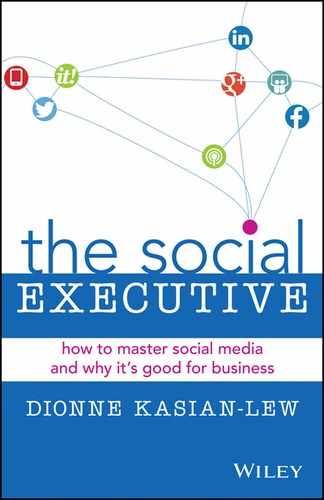CHAPTER 13
Facebook: your new lounge
As in real life, so online. You used to have family and friends around to your house to catch up. You’d update each other and share holiday snaps. Now your family and friends are scattered around the world. You still share updates and photos but you do so on Facebook. Facebook is your new lounge.
The backstory
The rise and rise of Facebook is like some sort of strange mash-up: startup fantasy meets college-humour flick, smart techy teenagers develop a popular but ultimately useless invention and get rich.
Sounds fun but much like a recipe for a fad, which is why many executives spent so long ignoring or dismissing it as the purview of kids. As the saying goes in social media (with a smiling emoticon to set the tone): #fail.
For anyone still anchored by the origins of this story, here’s the update.
The social network was indeed started by Harvard college students in 2003, originally as ‘Facemash’, which allowed students to compare photographs of fellow students side by side and choose who was ‘hot or not’. Founder Mark Zukerberg later applied the same idea to an art history project, uploading images and opening them to comments from classmates. What became clear was that whether it was of girls or Augustan art, the ability to view an image and immediately respond and share a view struck a chord with users.
Fast forward to 2014, Facebook is now a corporate giant with 1.25 billion users around the world. And at 10 years old — a long time in any business these days, let alone technology — it’s certainly surpassed fad status (http://expandedramblings.com/index.php/by-the-numbers-17-amazing-facebook-stats/).
On their own, numbers are easy to dismiss. But if you stop to think about it, the network is almost as populous as the two largest countries in the world, China and India. I don’t know where you live but here in Australia we’re edging towards 23 million citizens, relatively insignificant when compared with Facebook numbers.
With size comes reach. Already Facebook hosts over 80 million business pages, and that’s just from the more adventurous businesses or brands where marketers have been able to convince decision-makers of the value. Although there are more alternatives now than there were when the network erupted, as business becomes more comfortable with social engagement, the number of pages will surely grow.
Facebook also has the largest collection of online photos — around 240 billion on its server, with 350 million new photos uploaded each day. Although the love of video and photography is not slowing down, people’s preferences around managing images seem to be. Snapchat, for example, deletes photographs as soon as they are viewed, which has proved extremely popular with young users.
As for the baby-faced college kid, CEO Mark Zuckerberg is now a 30-year old billionaire leading 6000 employees of a listed company worth $100 billion (although obviously views about its true value vary considerably). Now the company faces legal action on a number of fronts, from charges of violating federal wiretap laws to a nationwide class action tracking cookie lawsuit, and has been investigated by Ireland’s Data Protection Commissioner (DPC) for privacy breaches. Zuckerberg’s company is also caught in the broader net of privacy issues facing US technology companies alleged to have illegally shared the private details of users with the National Security Agency (NSA) as part of their secret surveillance program known as PRISM.
Not such a fairytale anymore. And as for any mature business, changing times deliver risk as well as opportunities.
Right now many young users are migrating away from Facebook to platforms like Snapchat and Twitter. Of course millions of new users are also signing on. Interestingly, one of the fastest growing demographics on Facebook is people aged 45–54, which jumped 46 per cent in 2013. It’s probably no surprise that as adults become more adventurous about social networks their progeny will look elsewhere. But when they do it’s to a better alternative social media network, not away from social media.
Facebook is constantly evolving its offering in response to the changing environment and user preferences. In 2013 the platform introduced Graph Search, which is equivalent to a search engine (like Google) within the platform. Graph allows you to search the data of friends in your account — say, for that restaurant you vaguely recall someone posting about when they were in Vietnam. Users can also search topics in real time. For example, you can search up a particular sports game and connect to conversations people in your network are having about it, much like sitting around the TV with mates, only with fast forward.
In response to what seems like an unstoppable global appetite for video and photo content, Facebook bought Instagram with its 150 million monthly users to integrate into its offering.
Issues plaguing the giant may not go away easily but neither, it seems, will Facebook.
The impacts on business
Remember all those people who held out against buying mobile phones? Their dogged determination to prevent people from being able to reach them unless they were home? The idea that someone phoning if they were in a shopping centre or at the beach would diminish their quality of life? In retrospect, we reflect on these concerns as silly, but at the time many shared their fears.
Things have moved on and we have all adapted, as humans tend to do. There are now more mobile phones than there are people on Earth, and most of us feel anxious if we leave the phone behind when we’re on the move. Whether you think this is good or bad, it’s just the way it is. So too with Facebook. You may like it or loathe it, use or refuse it, but for billions of people around the world, it’s how they connect.
Which brings us to the impacts of Facebook for business. This is something that every executive needs to understand because the ubiquity of the network impacts the people in our business, our customers and the ways in which we do business (marketing, communication, customer services, research and sales).
This is not a book about Facebook for business (there are many), so my aim is simply to make you aware of some of the key issues that business leaders are facing in this space. They include:
- Facebooking on the job
- productivity impacts
- core hours (the professional/personal divide)
- the new recruiter.
Facebooking on the job
Facebook is likely being used throughout your organisation. People will be using it at work and after hours, on their personal devices and on devices that the business owns. It will be running in the background on many computers all day, sometimes passively. This is, or should be, the assumed and agreed starting point for any discussion. On what comes next, there’s wild disagreement.
One problem is that people are trying to find ways to squeeze the management of social behaviour into existing business frameworks, rather than questioning whether existing business frameworks are still relevant to the way we live. This is a more difficult question because it requires us to rethink organisational policies at the deeper level. My view is that in the coming times, whether or not we want to, we will have to face this question.
Some organisations have taken a hard line towards social networks, preventing staff from accessing them during work hours. The reason? To ensure employees remain focused and productive.
But what is really going on? People are checking them anyway. Instead of doing so openly at their desk they’re taking sneak peeks at their mobile phones. Socialising has always been one of the pleasures of work, whether it’s a chat at the water cooler or sharing morning tea. It may look a bit different, but it’s the same idea.
At the same time, businesses need to manage time and in certain industries distraction can be a health and safety hazard. Executives need to strike a balance. All too often, though, senior executives who are out of step with their people are making decisions. I know that’s a bitter pill to swallow, but bear with me.
The reality is that if you believe Facebook is a waste of time, then you’re unlikely to be amenable to a policy that allows people to access it from their desktop. And when someone challenges a core belief in which we’ve invested, at least in part, some of our identity, the tendency is to come out swinging.
We’ve all been there. When I took my previous organisation into social media in 2006 we were considered to be ahead of the curve. This was not because I fully understood the value. As far back as 1997 social style sites such as Six Degrees (now folded) were allowing users to set up their own and surf others’ profiles. These were people who could really see what was coming. I was fortunate to meet a number of individuals who opened my eyes to the value of these platforms, especially at organisational levels. Once I moved past resistance and started to read deeply about trends, review data and experiment, my views could be found down the end of the corridor, to the left — those views were turned on their head.
Productivity impacts
Creating productive teams and profitable outcomes (if you’re a for-profit) is the game, so concerns about productivity are understandable. But there is little evidence to suggest social media diminishes productivity. Despite this, it is often cited as a time waster.
What it does bring to light is that many productivity measures continue to emphasise inputs over outputs. A widget-focused leadership mindset will not equip managers to deal with the emerging complexity of the digital and social age.
There is research that suggests social media can enhance engagement, which is a key element of productivity. It’s well recognised, for example, that young professionals value internet connection above even a pay rise. A recent Cisco study found companies that embraced social media during business hours were more attractive to job applicants in highly competitive talent pools. It’s tempting to think of social networking as a concession to Millennials but the adoption of social media across all age groups suggests otherwise.
The value of digital to productivity means measuring direct contributions from pure online businesses but also the indirect activity of mixed businesses, including the use of social media for engagement, sales and customer service.
Core hours
We’ve all worked with them, the people who turn up at 7 am and throw disdainful glances at their colleagues as they arrive any time after, signalling disapproval with a glance at their watch or a dramatic sigh. Normally they’re reading the newspaper or they’re on the social round, but with the office light on and computer buzzing it’s clear they at least are serious.
This is the culture of input over output and one deeply entrenched in the notion of core hours. But what are core hours in 2014?
The distinction between personal and professional life has changed dramatically since the advent of the eight-hour workday, introduced as a result of the industrial revolution. We answer emails from colleagues at midnight and check Facebook at 11 am. Or prepare a PowerPoint while watching TV and status update our mates straight after we walk out of the performance review. The 10 minutes we lose between 9 and 5 we make up for between dinner and going to bed. Whether you think this is good or bad for us as a society, it’s what we do. The days of a sharp demarcation between our personal and work lives are gone, and I imagine the line will become even fuzzier as globalisation and interconnection increases.
This makes it very difficult to measure productivity by time within core hours. It also suggests that in future we need to concentrate our energies (where appropriate, of course — this cannot apply in every industry) on developing Key Result Areas that more accurately measure what people achieve.
The new recruiter
Here’s something else Zuckerberg may not have been thinking about when he hacked into Harvard databases to steal photographs: that Facebook would become one of the most powerful and popular recruitment tools, on both the buy and sell side of the equation.
Intuitively it makes sense. People within our network, usually family and friends, refer the majority of jobs. And a lot of those are now on Facebook. Then of course there’s LinkedIn, but I’ve already devoted a chapter to that.
I’ve seen Facebook work firsthand many times. While I was writing this chapter a friend who had been travelling for seven months (naturally we followed her around the world as she posted photos from wherever she was) got home and reached out for work. She simply wrote in her status update that she was on the lookout and within seconds the first comment came back. When I checked at the end of the day there were welcome backs and jokes about a less indulgent time ahead, warm leads — and by the end of the narrative she’d pretty much been offered part-time work (granted, not in her field) to get her going while she looked around. Not bad for 100 words posted from a café.
I’ve used my networks for colleagues in similar ways, in particular those who have not yet built their own. Recently the head of a PR agency specialising in what we would call traditional communications had to act fast when a client requested an online community manager as part of an engagement project. I posted with the key words #jobs #Melbourne #ORM and within a minute (yes, I am not exaggerating for dramatic effect) two viable candidates came back, one of whom ended up working on the project. Enough said.
But recruiters are also using social networks as part of locating, engaging with and checking potential recruits.
By the way, I don’t think we’ll see the recruitment industry disappearing as a result, although they are already changing the way they operate. While the advantages of interconnectivity include immediacy, openness and choice, the reality is we are very busy and are increasingly seeking ‘curators’ (including specialists) to manage the overwhelming choice on our behalf. But it does mean that, whether you’re looking or being looked at, the importance of a visible and well-regarded profile in these platforms will become increasingly important.
Me 3.0
Should you be using Facebook for your personal platform? How visible you want to be on Facebook depends, as ever, on what you want to achieve.
If, for example, building a fan base is core to your personal brand strategy then it could be a good idea.
Australian fitness guru Michelle Bridges is an excellent example of a micromaven whose personal brand is also her business and who uses Facebook to share her real-life expertise with clients even when she is not ‘there’ physically (www.facebook.com/12WBT?fref=ts).
But I’m going to assume that like most executives you’re ‘working for the wo/man’ and that while your marketers, communicators, and customer services and sales people should be studying every nuance, your use will be more limited.
I recommend that as an executive you think of it as your lounge. A place you are free to retreat to at the end of the day, and where it means something to the people who get to see and comment on photographs of the school concert. I love it for this. With almost no effort I can keep up with where people are and what they are doing. And I prefer this light but regular content to an older equivalent, the annual Christmas letter.
Personally, I apply the strictest privacy settings available on Facebook to all options and keep my sharing among friends. I’ve nonetheless set up Facebook pages for my business and personal blog as part of my ‘secure your social media assets’ strategy. I don’t engage heavily on my business pages but time is a significant factor, and I imagine it is for you too.
So let’s set up. Because this is for personal use I’m going to show you how to activate settings that will keep it just between those you choose. If you do want to friend a direct report, however, there are ways to limit the information they see.
Let’s go — Facebook
Facebook is not an essential part of your personal professional platform, though if you’re using it for business it’s a must. That doesn’t mean Facebook isn’t popular (it’s huge) or engaging (it’s one of the most engaging networks on the planet). It’s just that for busy executives, it’s a place to go where you can close the door and leave work behind you, so to speak.
For that reason we’re not going to spend too much time here, although I will give you a quick snapshot of how to set up Facebook and some things to look out for.
First head to Facebook.com. Sign up using your email (figure 13.1). Remember this is a Facebook account, so that’s you personally (though a business can also create a Facebook Page). Facebook requires you to use your real name.
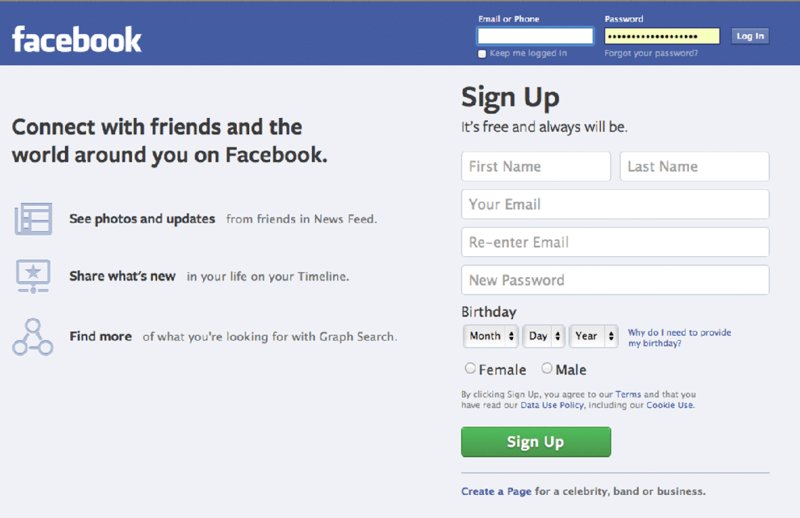
Figure 13.1 Facebook’s Home page
Fill out the level of detail you’re comfortable with. I leave a lot out here because my friends already know who I am. However, adding detail allows Facebook to make associations and suggestions that you might value. For example, if you fill in the name of the school you went to, Facebook will go through its databases to bring you suggestions of others who went there during that time. It could be a great way to reconnect with a past friend.
One thing you need to be conscious of in Facebook is choosing the right privacy settings. Because we’re not using it for marketing, we’re going to shut it down to friends only. To adjust these settings click on the padlock icon to open up to Privacy Shortcuts (figure 13.2).
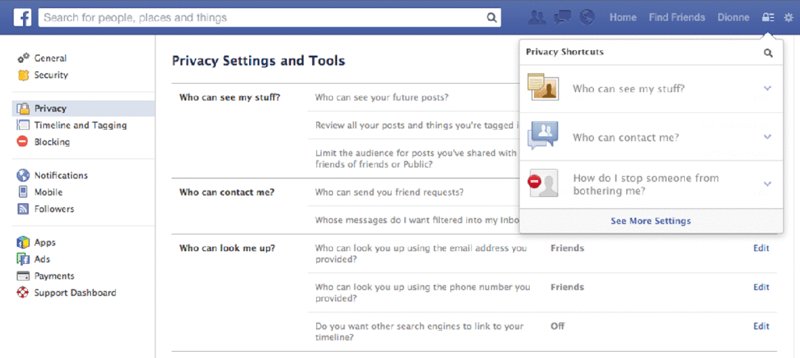
Figure 13.2 Facebook privacy settings
You can adjust settings for every part of Facebook, and you’ll have to do each manually. Just open up the Edit button. Choose Friends. You can customise what you want to share by opening the Custom icon, which looks like a little cog (figure 13.3).
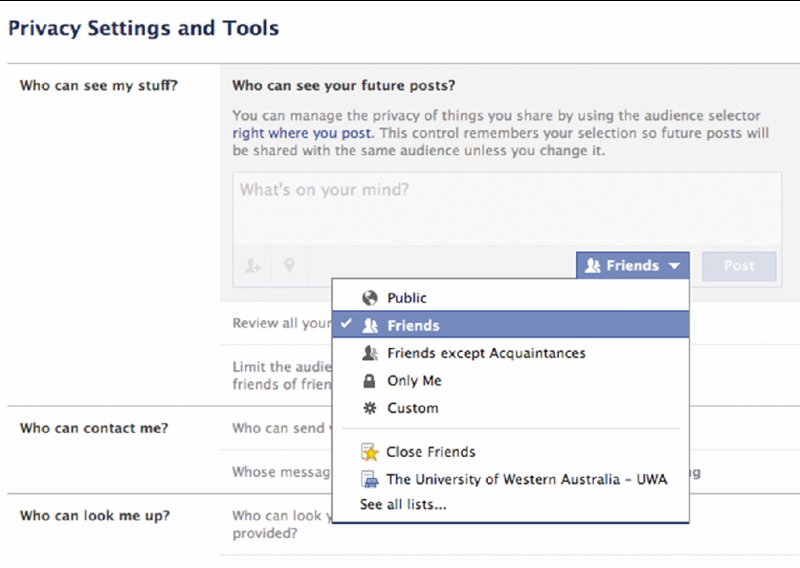
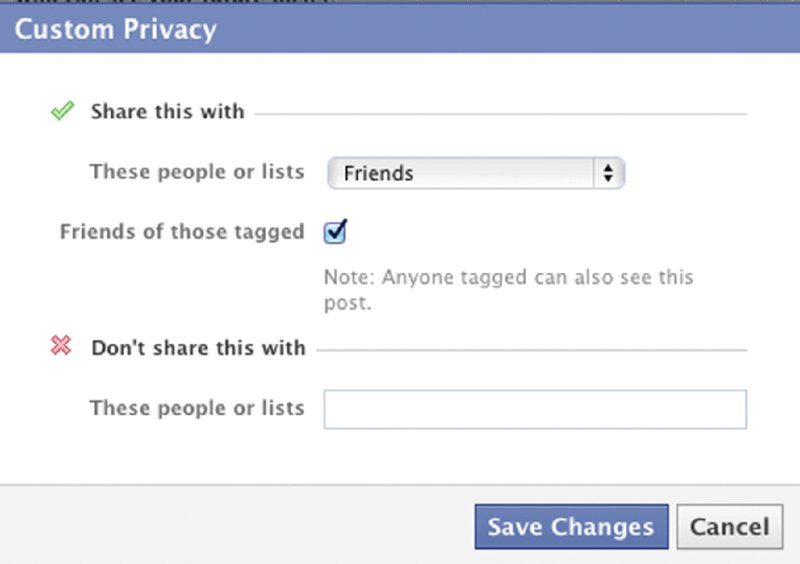
Figure 13.3 locking down privacy to Friends
You can also edit all your security settings (figure 13.4).
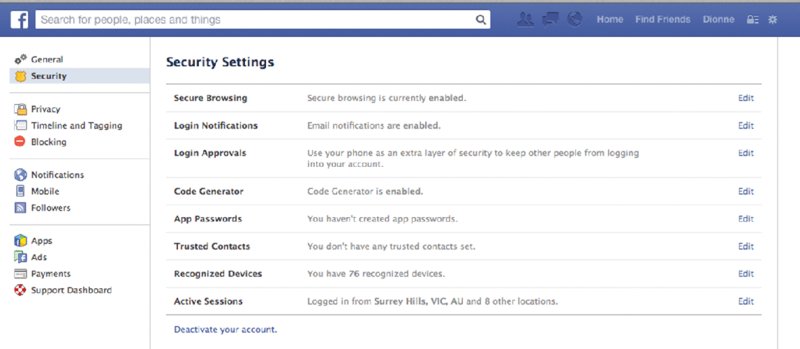
Figure 13.4 security settings
If you want to apply additional layers of security, such as a security code if your account is accessed from unknown browsers, just tick the box (figure 13.5).

Figure 13.5 adding levels of security
Facebook is easy to navigate. You can search within the Facebook network by using the Search icon (figure 13.6).

Figure 13.6 search function
The People icon allows you find and accept friends.
The Chat icon is your inbox. This is private and you can communicate with anyone you’re connected to.
Find Friends allows you to search for people based on a number of criteria (figure 13.7).

Figure 13.7 search people criteria
And your Home page can be found under your name (figure 13.8).

Figure 13.8 your Home page
You’ll see that I am using a non-professional photo here; that’s because it’s for friends rather than colleagues.
Here you can see your timeline, photos, friends and a number of other options.
This chapter will get you up and running on Facebook, but once you’ve learned the ropes you may want to amp it up with some bootcamp suggestions. These are pro tips. I’ve included sources for these great tips so you can look up authorities and follow their other fabulous suggestions.
Facebook bootcamp
- Although we’re using Facebook as a lounge, if you’re an entrepreneur or self-employed executive you may want to build influence here, because Facebook is great for marketing.
- Your cover image size should be 851 pixels by 315 pixels and may not include more than 20 per cent text. (Genevieve Lachance, Social Media Today)
- Share videos, not just still images. (Emeric Ernoult, Social Media Examiner)
- Create and manage an event on Facebook. This will help you reach your contacts and track their interest. (Josh Cantone, Mashable)
- Click on the icon in the upper right of each post and choose ‘Pin to top’ from the drop-down menu. From then on your post of choice will always be at the top of your page, no matter what you post afterwards. (Glyn Dewis)
- Post a picture and ask followers to post versions of their own or anything that will encourage them to post images as replies. (Andrew Gough)
Chapter summary
Facebook is a social networking phenomenon with more than 1.25 billion users. Executives must understand the issues associated with this platform, including its impact on communication inside and outside work.
Facebook is vital for business marketing, although for busy executives who want to balance the private and public it has a different function.
You used to catch up and share photos with family and friends; you still do, but because many are now scattered around the world you do so on Facebook. It’s your new social media lounge.
